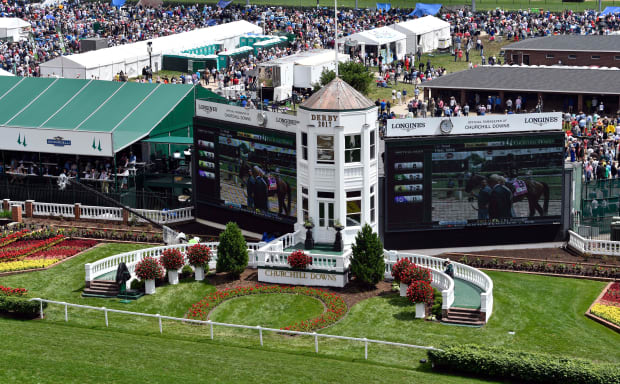LOUISVILLE, Ky.—Emily Bingham picked the lunch spot for our interview, and let’s just say the choice of restaurant was smart and shrewd on her part.
We slid into a booth at Wagner’s Pharmacy, a century-old place in Louisville’s South End that has transitioned over the years into a no-frills diner and gift shop. It is located across the street from Churchill Downs, feeding horsemen and racing fans soup and sandwiches and eggs and bacon. The place is a shrine to the sport, and to the Kentucky Derby specifically.
This was the perfect—and perfectly cheeky—location to discuss Bingham’s new book, My Old Kentucky Home: The Astonishing Life and Reckoning of an Iconic American Song. It is an unflinching, brilliantly written study of the song that is synonymous with the Derby—the one that will bring as many as 150,000 horse racing fans to their feet at Churchill on Saturday, many with tears in their eyes, as they boozily sing along to Stephen Foster’s 1853 tune.
How many of those 150,000 know that “My Old Kentucky Home” is steeped in racism? Whitewashed and inauthentically presented as Southern sentimentalism? Packaged as a paean to soft-edged nostalgia, when in reality its lyrics tell a tale of a slave being taken from his family and sold downriver to die on a sugarcane plantation?
It's not just that racist terms for Black people had to be changed to “people” in the latter half of the 20th century, in varying stages by various institutions, to make the singing more palatable. It’s not just the second and third verses, rarely sung, that paint an increasingly bleak picture of a displaced slave’s existence. It’s more than that.
It’s everything else that the song became: a mainstay of minstrel shows produced and performed by white people in blackface, a symbol of the romanticized “Lost Cause” version of the Confederacy, a one-size-fits-all prop for patriotism, and the underpinning of a Kentucky state park and tourist attraction based almost entirely on fraudulent narrative.

Jamie Rhodes/USA TODAY Sports
Read Bingham’s book, and some Derby goers may never stand and sing “My Old Kentucky Home” again. The 58-year-old Louisville native, historian, author and lecturer at Bellarmine University certainly won’t.
“I don’t believe it can be wrong to love a song, but I do believe we commit wrongs when we do not understand what we claim to love,” she wrote. “Refusing to look closely at uncomfortable aspects of history has hurt this nation and may be its undoing. … Nearly 170 years ago, Foster copyrighted Black loss for white pleasure, comfort, and distraction. Over time, American society erected ‘My Old Kentucky Home’ as a sonic monument—impressive, opaque, and also contested—to white feeling and white forgetting, to a nation’s own segregated memory.”
That is the largely ignored baggage weighing upon the official Kentucky state song, and its inextricable tie to the state’s signature cultural/sporting event. The fact that is being brought to our attention by a woman with the last name “Bingham” adds another layer of resonance.
The Binghams are one of the most prominent families in Louisville history. Three generations of Binghams ran a local media empire, with controlling ownership of The Courier-Journal and The Louisville Times newspapers, two radio stations and a TV station. The quality of the journalism and the civic pride in those media outlets were both high. (Disclosure: I worked for The Courier-Journal for 17 years, but did not start there until after the Binghams sold the paper to Gannett.)
The media empire was dissolved in the 1980s, but the family name still carries cachet locally. For a scion of one Louisville institution to take on another Louisville institution (Churchill Downs and the Derby) is an eyebrow raiser. But it’s in line with the Bingham family’s progressive newspapering, and with a years-long inability to reconcile Kentucky’s continued embrace of a song about a terrible period in U.S. history.
“In South Africa they don’t sing songs about apartheid before a cricket game,” Bingham says. “In Germany they don’t sing songs about the Holocaust before a soccer match. How did it come to have this kind of weight in our sport and our state?”
The answer is a progressive layering of falsehoods, sidesteps, rationalizations and capitulations to capitalism. Foster, considered by many to be the father of American pop music but struggling badly to make a living at the time, produced a catchy melody and wrote lyrics derived from the novel, Uncle Tom’s Cabin. The song became a fixture of traveling minstrel shows, wherein white actors performed demeaning Black stereotypes that somehow were hailed as “authentic” depictions.
After the Civil War, part of the false interpretation and marketing of the song was the notion that slaves were happy in their station and grateful to their benevolent white owners. Thus, in the repurposing of Foster’s song, the slave sold downriver missed his carefree existence in Kentucky. This was an element of the post-Reconstruction softening of what the Confederacy was and what it stood for, part of redirecting memory toward the “Lost Cause” and away from the reality of America’s Original Sin.
Later in the country’s history, the song was expropriated altogether as white Old South experience. Idyllic plantation life was the presumptive backdrop, which gained traction in part thanks to the extraordinary creative license taken with My Old Kentucky Home State Park in Bardstown, Ky. The tourist attraction once sold the demonstrably false story line that Foster wrote “My Old Kentucky Home” there at the restored Federal Hill mansion, where it’s more likely the Pittsburgh native spent no more than a few hours of his adult life in the state, and that stopover was 50 miles away in Louisville.
Amid all the misunderstanding and misrepresentation, Bingham’s goal is to put a light of truth on what the song was. She wants readers to understand how it is part of a cultural patchwork that has deeply troubled Blacks—and Black Kentuckians, specifically.
“What I would love this book to do is to take something that is in so many people’s hearts, that they have positive feelings about, and understand that those feelings are just the tip of a systemic iceberg of things we don’t realize that have been contributing—over years, over generations—to a continuation of inequity,” she says. “This is a microcosmic example of one song being systematized and put on a pedestal in a way we enshrine something that’s hurtful and a story that doesn’t tell us who we are. We have to keep peeling those layers back. We have to acknowledge things that have happened.”

Courtesy of Emily Bingham
Circling back to the Kentucky Derby: Matt Winn, the irrepressible marketer who helped turn Churchill into a cathedral of American sport, first linked the Derby and “My Old Kentucky Home” in a powerful partnership in 1931. The song was nearly 80 years old then, but it gained fresh currency as the Derby became one of the signature sporting events of spring. Since then, the bonds between horse race and song have deepened.
In 2020 in the immediate aftermath of the murder of George Floyd and in a city torn asunder after the death of Breonna Taylor, the Kentucky Derby was postponed to Labor Day weekend by the coronavirus pandemic. Given the context of the time, Bingham was hopeful Churchill Downs would choose that moment to not play “My Old Kentucky Home” before the Derby. The racetrack chose a different path—keeping the song but having it played by a bugler in front of a near-empty grandstand, with virtually no one there to sing the troubling lyrics.
Churchill has made several public efforts to promote greater diversity and inclusion in horse racing. It wasn’t always in need of improvement in that area—the sport was dominated by Black jockeys in the late 1800s, when the Derby was in its early years. But today, Black participation is scant.
Among the initiatives was an announcement this week that Churchill and the Kentucky government are partnering with the Ed Brown Society, which promotes opportunities for people of color to participate in the racing industry through jobs and internships. The financial commitment is a tangible step, but don’t expect it to be accompanied by a symbolic disassociation with “My Old Kentucky Home.”
“It’s the state song,” Churchill Downs Incorporated CEO Bill Carstanjen says. “It has been for over 100 years. It’s overwhelmingly supported by our fans. It’s part of the tradition, part of the fabric of the event. We plan to continue playing it with our signature event.”
Emily Bingham isn’t attending this year’s race in person, opting instead to watch at home with her 10-year-old niece. She will not be standing when “My Old Kentucky Home” is played.







